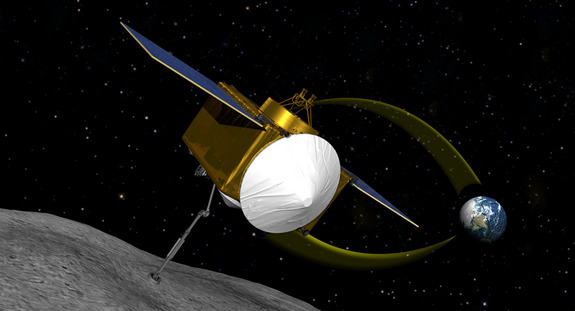NASAcronyms: How OSIRIS-REx Got Its Name

If Osiris, ancient Egyptian god of the underworld, and Tyrannosaurus rex, king of the dinosaurs, somehow had a baby, and that baby was an asteroid-bound spacecraft, it would be named OSIRIS-REx.
Yes, OSIRIS-REx is the acronym for the vessel that, NASA just announced, will launch in 2016, travel four years to an asteroid, chip off some rock samples and bring them back to Earth. The combination robot-spacecraft is the brainchild of researchers at the University of Arizona Lunar and Planetary Lab. And so is its funky name.
The deputy principle investigator of the OSIRIS-REx team, Dante Lauretta, is a mythology buff. "Why he has this interest I have no idea," principle investigator Michael Drake told Life's Little Mysteries, "but he was doodling on a pad and trying to capture the principal themes of what we are trying to do with this mission study life origins , identify resources, planetary security in the form of asteroid deflection and he realized he got the name of Osiris out of that, an ancient god of Egypt who may have been one of the first pharaohs."
OSIRIS stands for "Origins-Spectral Interpretation-Resource Identification-Security."
When asked if there was disagreement among the team members about the choice of acronym, Drake said, "The only person whose opinion mattered, frankly, was me, and I liked it right away."
REx, for "Regolith Explorer," was tacked on later, when the researchers designed a new and improved "king" version of an earlier model named, simply, OSIRIS. "Rex" means "king" in Latin. Regolith is rocky asteroid surface material.
The story of Osiris (the Egyptian) loosely parallels that of OSIRIS-REx (the asteroid mission). As a result of a mean trick involving a bejeweled coffin, Osiris was killed by his evil twin brother. His body was cut up into pieces and dumped in the Nile, and the pieces traveled down the river and spread agriculture all over Egypt.
Sign up for the Live Science daily newsletter now
Get the world’s most fascinating discoveries delivered straight to your inbox.
OSIRIS-REx, Drake explained, will collect samples of regolith that, once brought back to Earth, will be distributed all over the world for scientists to analyze. Those samples may help the world understand the origins of organic materials.
"We were taken by it because it was a nifty name, because it matched what we wanted to do, but also because it matched the mythology a little bit," Drake said.
And there you have it: OSIRIS-REx.
Follow Natalie Wolchover on Twitter @nattyover.
Natalie Wolchover was a staff writer for Live Science from 2010 to 2012 and is currently a senior physics writer and editor for Quanta Magazine. She holds a bachelor's degree in physics from Tufts University and has studied physics at the University of California, Berkeley. Along with the staff of Quanta, Wolchover won the 2022 Pulitzer Prize for explanatory writing for her work on the building of the James Webb Space Telescope. Her work has also appeared in the The Best American Science and Nature Writing and The Best Writing on Mathematics, Nature, The New Yorker and Popular Science. She was the 2016 winner of the Evert Clark/Seth Payne Award, an annual prize for young science journalists, as well as the winner of the 2017 Science Communication Award for the American Institute of Physics.










